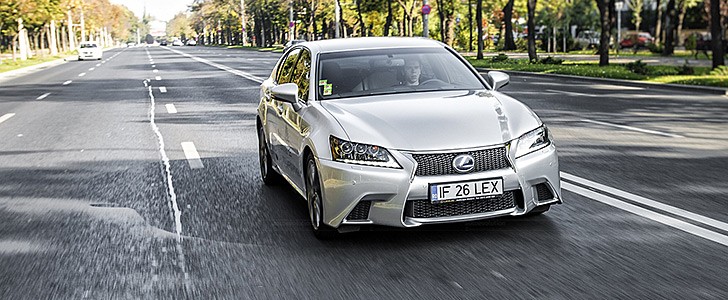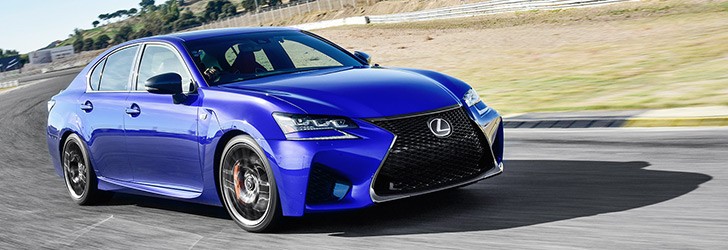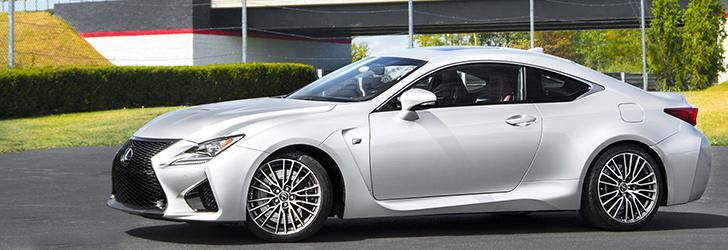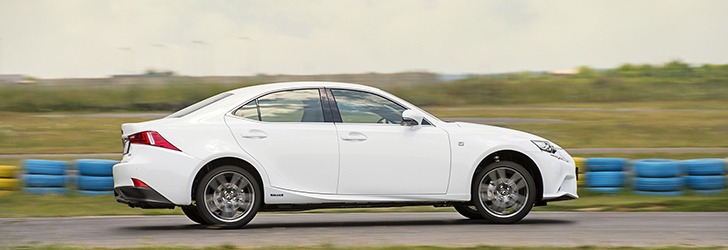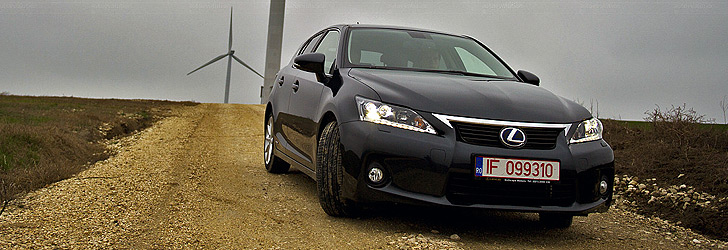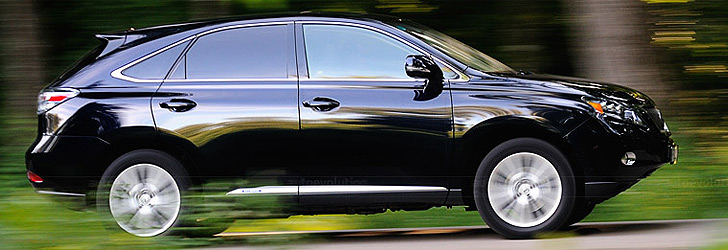LEXUS GS 450h Review
OUR TEST CAR: LEXUS GS 450h F Sport 2013
Lexus has made a habit out of choosing various brand ambassadors and the people that represent the company range from Kylie Minogue to former F1 champion Alan Jones. We wouldn’t choose any of them as a Lexus brand ambassador like the company did. Instead of offering this title to VIPs, we’d give it to the new GS and that's because this car was designed with the core Lexus values in mind. The carmaker wanted to take customers even further into its own territory in the battle with the dominant German competitors.
The styling of the compact executive is one of the key Lexus values at the moment and the models that arrive after it will borrow many of its features. And those lines conceal an engine range that will never accept diesel in its tank. This was also true for the previous three generations, but choosing such a bold pathway nowadays, when even US models offer an oil burner, says something about the Japanese automaker.
While the current, fourth-generation GS, is of great visual importance for Lexus models that will follow, the first GS was the car that allowed the LS flagship to move upmarket. The first generation (1991), as well as the second one (1997), also had a Toyota equivalent, which was called Aristo.
Those of you who are impressed with the new car’s four-wheel steering system should know that the second generation of the GS also offered integral steering. The second incarnation of the GS was also the one that placed the spotlights on the car, enjoying much more success compared to the one before it.
When the third generation of the LS was launched in 2004, Toyota did away with the Aristo as part of a bigger plan to establish a strong global image for the Lexus brand. Just like the current GS, the one before it served as a styling hint for the cars that would follow. It was this incarnation of the GS that saw the car adopting petrol-electric power and truly becoming a technological display.
We recently got the behind the wheel of the hybrid model, which, just like in the case of the previous generation, was placed at the top of the range. We drove the GS 450h in the F Sport trim that adds both visual and technical drama. Let's see how these are translated into driving reality.
Lexus’ new mid-size compact executive was previewed by the LF-Gh concept, which the company explained would serve as a styling direction for all its future models. The production GS that followed wasn’t introduced at an auto show, making its world premiere at the Pebble Beach Concours d’Elegance instead.
Compared to the previous generation, the car has kept the same length, has gained 20 mm (0.79 inches) in width and 30 mm (1.18 inches) in height. Despite the little change in dimensions, the platform makes better use of these and the proportions give the GS a sportier appearance.
To be more precise, the front overhang is shorter by 10 mm (0.39 inches), the same amount by which the rear overhang has been increased. As for the tracks, the front one gains 40 mm (1.57 inches) and the rear one is now 50 mm (1.97 inches) wider.
The new design is dominated by the prominent front grille, which mixes the previous inverted trapezoid upper grille and tilted lower one. The side air intakes in the front fascia, which are visibly pushed back compared to the grille, are fake. However, there are two openings on the side of the aforementioned grille, which are used for cooling the front brakes. The GS450h uses dedicated headlights that come with an adaptive full-LED three-lamp construction, which accompanies the LED daytime running lights.
For the profile, the car has kept its predecessor’s silhouette, as well as the slingshot shape for the glass area. The roofline has bee raised by 15 mm (in) though, as Lexus wanted additional rear head room and luggage capacity. The panel gaps, as well as the gaps between the wheel arches and the tires are now smaller,
The rear of the GS accommodates aerodynamic tweaks aimed at reducing drag and also offering a high-speed stability boost. The taillights incorporate fins, which, together with the shape of the boot area, send the air over and past the car’s body. As for the air that goes under the car, this is controlled by the rear bumper diffuser. Lexus has used a little trick that aims to make the hybrid model look greener, covering the exhaust pipes.
The F Sport pack of our test car brings, among others, multiple exterior changes. The front apron has an even more sculpted design, with larger side grilles and a dedicated mesh grille. The rear diffuser uses grey metallic paint, as well as an additional chromed element. There’s also a specific bootlid spoiler, as well as a set of special 19-inch wheels.
The combination between the aforementioned elements brings an effect that sets the F Sport apart from the standard GS, which is already a car with a sporty design.
The cabin of the GS450h F Sport continues the dynamic theme of the exterior, with the last part of the car’s designation bringing a flood of sporty elements inside the car.
Once you open the door and go past the special entry sill, you’ll notice the extravagant pedals, as well as the perforated leather on the steering wheel and gearshift lever.
In fact, the dedicated F Sport leather upholstery also covers the seats. And these aren’t any seats - they use complex shapes that accentuate the cocoon feeling offered by the rest of the cabin and are 16-way power adjustable, with heating and ventilation.
The aforementioned feeling is combined with a certain degree of focus on the driver, which is not just achieved through the sporty controls, but also with the help of the Head Up Display, albeit an unit that feels old.
The interior ambiance is given a final touch by the black headliner and the aluminum trimming.
However, unless the driver makes adjustment each time he starts the car, he isn't treated with a rev counter, receiving an instrument that displays how the energy is used. Like we said, you can transform this into a rev counter, but only if you choose to enter the sporty area of the car's Drive Mode Select System.
The F Sport pack plays its part well and it is accompanied by other assets of the cabin, such as the generous space and the good visibility. And if you’d expect the cabin of a car that belongs to this segment to be spacious, we couldn’t say the same thing about the boot, but this offered us a pleasant surprise.
The luggage capacity of hybrid vehicles is usually crippled by the battery pack, but the GS450h proves to be a brilliant exception. The vehicle can swallow 465 liters, compared to a non-hybrid GS, which has a boot capacity of 530 liters (cu. ft.). Thanks to the F Sport trim, the lid can be closed using electric assistance.
The interior also has a dark side, one that starts with the ergonomics. It takes a certain amount of time to get used to all the buttons and controls, but the real issue comes from the Lexus Remote Touch Interface. This uses a controller that mimics the moves of a computer mouse, but, unlike its previous version, you can’t navigate freely, as you have to use pre-determined areas of the screen. This defeats the purpose of simulating mouse movements, which made Lexus' feature unique and easy to use after a short period of getting used to.
The F Sport pack brings a 12.3-inch display inside the car, but the graphic interface looks outdated. This problem is shared with some of the interior plastics, which make the car feel a little old from the first moments you climb aboard. The negative elements manage to cancel many of the benefits of the other interior parts, keeping the car from impressing you.
The GS 450h F Sport has multiple aces up its sleeve that allow it to perform well inside the city and the car manages to make good use of these qualities.
The vehicle may offer a generous interior space, but, thanks the class it belongs to it's not impossible to maneuver it in tighter spaces. When things really become serious from this point of view (read: parking), you can rely on the car's parking assistance (all-round sensors and reverse camera) to perform a pretty quick maneuver.
But the real asset that serves the GS well within the limits of the city is the all-wheel steering included in the F Sport package. This makes the car feel considerably smaller than it actually is and you'll enjoy its benefits everyday.
The good all-round visibility and the comfortable setup of the car also make it a good city player. And it's not the just the passenger that will appreciate the urban experience, but the car itself doesn't seem to be bothered by the complicated traffic.
That's because the hybrid powertrain is versatile and can easily adapt to the complex driving situations that arise during the daily urban driving. And while many hybrids sacrifice luggage space, the intelligent packaging used for this model means that shopping is an activity that runs smoothly, at least as far as the car-related part is concerned.
The dimensions and weight of the GS kept it from receiving even more points at this chapter, as there's only so much technology can do, but the GS proves to be a satisfying urban machine.
This Lexus certainly knows how to use the plethora of technological features detailed in the Tech facts chapter in order to become a perfect long trip partner.
The story starts with the comfort provided by the suspension, the seats and the soundproofing. These assets mix with the technical ones, which make the car feel capable when driven up to seven tenths.
The complex electronics make sure that the vehicle is always adapted to the driving conditions, keeping both the driver and the passengers happy. Add to this the multitude of gadgets and you'll obtain a car that knows how to shorten distances.
When moving on to the sporty part of the story, the GS shows a different face, failing to deliver on its promises. That's quite a shame considering that Lexus aggressively markets this as a dynamic vehicle.
Take a look at the exterior and the cabin of our test car - they're screaming "driving dynamics!" Especially in the F Sport trim, the GS450h also doubles these features with technical ones that could allow it to be a driver's car, but this is not the case. With the exception of the launch, the acceleration fits the aforementioned profile, but the handling and the braking fall short of it.
The 0 to 62 mph sprint takes 5.9 seconds, a respectable value, but what the official figures don't tell you is that the car offers two sides in terms of acceleration. The take-off is far from spectacular, but once you're on the move, petrol and electricity work together and you really feel the force of the powertrain.
Thanks to the generous muscle, you never have the sluggish sensations offered by E-CVT transmissions working with small engines. Instead, the GS 450h delivers a constant solid push once it gets past start phase and is happy to be taken to its 250 km/h (155 mph) top speed.
The transmission also offers a manual mode, which comes with steering wheel-mounted paddles, simulating six actual gears. While the paddles themselves are pleasant to use, we didn't find ourselves in this mode very often. The system does manage to avoid feeling artificial, but this setup simply doesn't suit the car's character.
Ahead of the gear shift select lever, you can find a knob that's just as important for controlling the car. Turn this and you'll navigate through the various settings of the Drive Mode Select System: Eco, Normal, Sport S and Sport S+.
The ECO Drive Mode offers a softer mapping for the engine and throttle pedal, as well as using energy-efficient control for the air conditioning system.
Sport S brings up the engine responsiveness, as well as the drive force available from the hybrid powertrain. In this mode, the meter back lights turns to red.
Sport S+ brings the same powertrain sharpness as Sport S, while also stiffening up the suspension and sharpening up the steering.
You can truly feel the difference between these as you move from hugging trees to hugging the road. Alas, the suspension is an exception to this. While it manages to filter road imperfections brilliantly, when you switch to Sport S+, it fails to provide the expected level of handling, still allowing a fair degree of body roll.
The problem is that when you throw the car into a corner, the aggressive four-wheel steering, which feels like a nice toy to have, generates forces that put the suspension through quite a big pain. Couple this with the aforementioned body roll level and you'll end up with a setup that's anything but inspiring.
In terms of braking, the vehicle comes with a regenerative setup. The engineers may have managed to integrate this in a way that delivers a natural pedal feel, but they haven't solved the usual problem with this kind of hardware - the lack of serious stopping power. When you're up to speed and you need to quickly loose some of it, the brakes make you regret for having gotten to that point.
The styling of the compact executive is one of the key Lexus values at the moment and the models that arrive after it will borrow many of its features. And those lines conceal an engine range that will never accept diesel in its tank. This was also true for the previous three generations, but choosing such a bold pathway nowadays, when even US models offer an oil burner, says something about the Japanese automaker.
While the current, fourth-generation GS, is of great visual importance for Lexus models that will follow, the first GS was the car that allowed the LS flagship to move upmarket. The first generation (1991), as well as the second one (1997), also had a Toyota equivalent, which was called Aristo.
Those of you who are impressed with the new car’s four-wheel steering system should know that the second generation of the GS also offered integral steering. The second incarnation of the GS was also the one that placed the spotlights on the car, enjoying much more success compared to the one before it.
When the third generation of the LS was launched in 2004, Toyota did away with the Aristo as part of a bigger plan to establish a strong global image for the Lexus brand. Just like the current GS, the one before it served as a styling hint for the cars that would follow. It was this incarnation of the GS that saw the car adopting petrol-electric power and truly becoming a technological display.
We recently got the behind the wheel of the hybrid model, which, just like in the case of the previous generation, was placed at the top of the range. We drove the GS 450h in the F Sport trim that adds both visual and technical drama. Let's see how these are translated into driving reality.
Lexus’ new mid-size compact executive was previewed by the LF-Gh concept, which the company explained would serve as a styling direction for all its future models. The production GS that followed wasn’t introduced at an auto show, making its world premiere at the Pebble Beach Concours d’Elegance instead.
Compared to the previous generation, the car has kept the same length, has gained 20 mm (0.79 inches) in width and 30 mm (1.18 inches) in height. Despite the little change in dimensions, the platform makes better use of these and the proportions give the GS a sportier appearance.
To be more precise, the front overhang is shorter by 10 mm (0.39 inches), the same amount by which the rear overhang has been increased. As for the tracks, the front one gains 40 mm (1.57 inches) and the rear one is now 50 mm (1.97 inches) wider.
The new design is dominated by the prominent front grille, which mixes the previous inverted trapezoid upper grille and tilted lower one. The side air intakes in the front fascia, which are visibly pushed back compared to the grille, are fake. However, there are two openings on the side of the aforementioned grille, which are used for cooling the front brakes. The GS450h uses dedicated headlights that come with an adaptive full-LED three-lamp construction, which accompanies the LED daytime running lights.
For the profile, the car has kept its predecessor’s silhouette, as well as the slingshot shape for the glass area. The roofline has bee raised by 15 mm (in) though, as Lexus wanted additional rear head room and luggage capacity. The panel gaps, as well as the gaps between the wheel arches and the tires are now smaller,
The rear of the GS accommodates aerodynamic tweaks aimed at reducing drag and also offering a high-speed stability boost. The taillights incorporate fins, which, together with the shape of the boot area, send the air over and past the car’s body. As for the air that goes under the car, this is controlled by the rear bumper diffuser. Lexus has used a little trick that aims to make the hybrid model look greener, covering the exhaust pipes.
The F Sport pack of our test car brings, among others, multiple exterior changes. The front apron has an even more sculpted design, with larger side grilles and a dedicated mesh grille. The rear diffuser uses grey metallic paint, as well as an additional chromed element. There’s also a specific bootlid spoiler, as well as a set of special 19-inch wheels.
The combination between the aforementioned elements brings an effect that sets the F Sport apart from the standard GS, which is already a car with a sporty design.
The cabin of the GS450h F Sport continues the dynamic theme of the exterior, with the last part of the car’s designation bringing a flood of sporty elements inside the car.
Once you open the door and go past the special entry sill, you’ll notice the extravagant pedals, as well as the perforated leather on the steering wheel and gearshift lever.
In fact, the dedicated F Sport leather upholstery also covers the seats. And these aren’t any seats - they use complex shapes that accentuate the cocoon feeling offered by the rest of the cabin and are 16-way power adjustable, with heating and ventilation.
The aforementioned feeling is combined with a certain degree of focus on the driver, which is not just achieved through the sporty controls, but also with the help of the Head Up Display, albeit an unit that feels old.
The interior ambiance is given a final touch by the black headliner and the aluminum trimming.
However, unless the driver makes adjustment each time he starts the car, he isn't treated with a rev counter, receiving an instrument that displays how the energy is used. Like we said, you can transform this into a rev counter, but only if you choose to enter the sporty area of the car's Drive Mode Select System.
The F Sport pack plays its part well and it is accompanied by other assets of the cabin, such as the generous space and the good visibility. And if you’d expect the cabin of a car that belongs to this segment to be spacious, we couldn’t say the same thing about the boot, but this offered us a pleasant surprise.
The luggage capacity of hybrid vehicles is usually crippled by the battery pack, but the GS450h proves to be a brilliant exception. The vehicle can swallow 465 liters, compared to a non-hybrid GS, which has a boot capacity of 530 liters (cu. ft.). Thanks to the F Sport trim, the lid can be closed using electric assistance.
The interior also has a dark side, one that starts with the ergonomics. It takes a certain amount of time to get used to all the buttons and controls, but the real issue comes from the Lexus Remote Touch Interface. This uses a controller that mimics the moves of a computer mouse, but, unlike its previous version, you can’t navigate freely, as you have to use pre-determined areas of the screen. This defeats the purpose of simulating mouse movements, which made Lexus' feature unique and easy to use after a short period of getting used to.
The F Sport pack brings a 12.3-inch display inside the car, but the graphic interface looks outdated. This problem is shared with some of the interior plastics, which make the car feel a little old from the first moments you climb aboard. The negative elements manage to cancel many of the benefits of the other interior parts, keeping the car from impressing you.
The GS 450h F Sport has multiple aces up its sleeve that allow it to perform well inside the city and the car manages to make good use of these qualities.
The vehicle may offer a generous interior space, but, thanks the class it belongs to it's not impossible to maneuver it in tighter spaces. When things really become serious from this point of view (read: parking), you can rely on the car's parking assistance (all-round sensors and reverse camera) to perform a pretty quick maneuver.
But the real asset that serves the GS well within the limits of the city is the all-wheel steering included in the F Sport package. This makes the car feel considerably smaller than it actually is and you'll enjoy its benefits everyday.
The good all-round visibility and the comfortable setup of the car also make it a good city player. And it's not the just the passenger that will appreciate the urban experience, but the car itself doesn't seem to be bothered by the complicated traffic.
That's because the hybrid powertrain is versatile and can easily adapt to the complex driving situations that arise during the daily urban driving. And while many hybrids sacrifice luggage space, the intelligent packaging used for this model means that shopping is an activity that runs smoothly, at least as far as the car-related part is concerned.
The dimensions and weight of the GS kept it from receiving even more points at this chapter, as there's only so much technology can do, but the GS proves to be a satisfying urban machine.
This Lexus certainly knows how to use the plethora of technological features detailed in the Tech facts chapter in order to become a perfect long trip partner.
The story starts with the comfort provided by the suspension, the seats and the soundproofing. These assets mix with the technical ones, which make the car feel capable when driven up to seven tenths.
The complex electronics make sure that the vehicle is always adapted to the driving conditions, keeping both the driver and the passengers happy. Add to this the multitude of gadgets and you'll obtain a car that knows how to shorten distances.
When moving on to the sporty part of the story, the GS shows a different face, failing to deliver on its promises. That's quite a shame considering that Lexus aggressively markets this as a dynamic vehicle.
Take a look at the exterior and the cabin of our test car - they're screaming "driving dynamics!" Especially in the F Sport trim, the GS450h also doubles these features with technical ones that could allow it to be a driver's car, but this is not the case. With the exception of the launch, the acceleration fits the aforementioned profile, but the handling and the braking fall short of it.
The 0 to 62 mph sprint takes 5.9 seconds, a respectable value, but what the official figures don't tell you is that the car offers two sides in terms of acceleration. The take-off is far from spectacular, but once you're on the move, petrol and electricity work together and you really feel the force of the powertrain.
Thanks to the generous muscle, you never have the sluggish sensations offered by E-CVT transmissions working with small engines. Instead, the GS 450h delivers a constant solid push once it gets past start phase and is happy to be taken to its 250 km/h (155 mph) top speed.
The transmission also offers a manual mode, which comes with steering wheel-mounted paddles, simulating six actual gears. While the paddles themselves are pleasant to use, we didn't find ourselves in this mode very often. The system does manage to avoid feeling artificial, but this setup simply doesn't suit the car's character.
Ahead of the gear shift select lever, you can find a knob that's just as important for controlling the car. Turn this and you'll navigate through the various settings of the Drive Mode Select System: Eco, Normal, Sport S and Sport S+.
The ECO Drive Mode offers a softer mapping for the engine and throttle pedal, as well as using energy-efficient control for the air conditioning system.
Sport S brings up the engine responsiveness, as well as the drive force available from the hybrid powertrain. In this mode, the meter back lights turns to red.
Sport S+ brings the same powertrain sharpness as Sport S, while also stiffening up the suspension and sharpening up the steering.
You can truly feel the difference between these as you move from hugging trees to hugging the road. Alas, the suspension is an exception to this. While it manages to filter road imperfections brilliantly, when you switch to Sport S+, it fails to provide the expected level of handling, still allowing a fair degree of body roll.
The problem is that when you throw the car into a corner, the aggressive four-wheel steering, which feels like a nice toy to have, generates forces that put the suspension through quite a big pain. Couple this with the aforementioned body roll level and you'll end up with a setup that's anything but inspiring.
In terms of braking, the vehicle comes with a regenerative setup. The engineers may have managed to integrate this in a way that delivers a natural pedal feel, but they haven't solved the usual problem with this kind of hardware - the lack of serious stopping power. When you're up to speed and you need to quickly loose some of it, the brakes make you regret for having gotten to that point.
12
Our LEXUS Testdrives:
Photo gallery (85)
